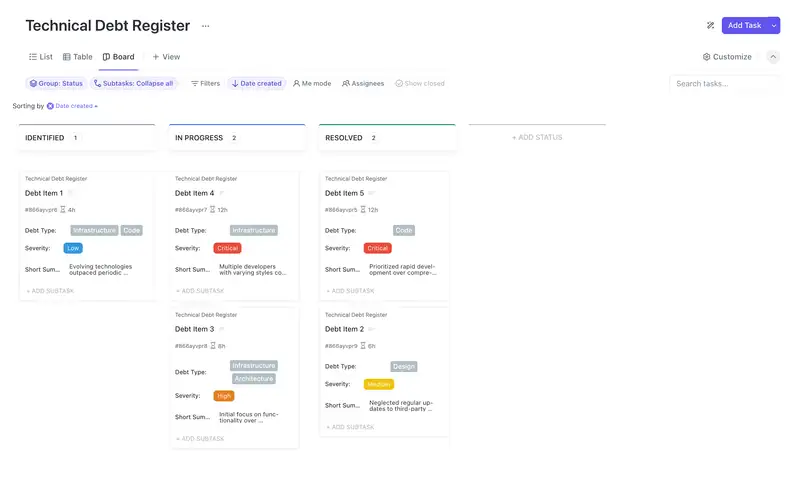Tired of hidden tech issues slowing down your projects? Our comprehensive Technical Debt Register is your key to seamless development. Easily track, prioritize, and manage technical debt, ensuring your software stays lean and efficient.
Introduction to Technical Debt and Its Management
Technical debt is a term widely familiar in software engineering, referring to the accumulated cost of cutting corners in software development, leading to additional work down the road. Just like financial debt, technical debt incurs interest — the longer it's left unaddressed, the more time and resources will be needed to rectify it later. Consequently, proper management of technical debt is paramount for maintaining an efficient and sustainable codebase, particularly as projects evolve and scale.
For software development teams and project managers, keeping track of technical debt is challenging without a structured approach. Enter the Technical Debt Register, a crucial tool meant for documenting, prioritizing, and managing technical debt over time. It provides an organized framework for tech teams to integrate debt management into their everyday workflow.
Understanding Technical Debt
At its core, technical debt is a metaphorical representation of later work stemming from earlier expedient but suboptimal technology choices, spanning from a tangled database schema to spaghetti code, all of which can impact a system's maintenance and performance. Causes of technical debt can vary:
- Database Inconsistencies: Rushed schema designs might lead to expensive migrations later.
- API Constraints: Hastily designed interfaces may limit future integration capabilities.
- Business Logic Complications: Overlooked complexities can brew a concoction of convoluted logic, ripe for bugs.
- Interoperability Issues: Neglecting system compatibility can lead to a debt that's expensive to reconcile.
The four quadrants of technical debt, as identified by Martin Fowler, serve as a conceptual model to understand its various forms — whether intentional or unintentional, reckless, or prudent.
The Dangers of Technical Debt
Technical debt can lead to several undesirable outcomes like codebase rigidity, decreased productivity, and inflated costs — seen in many instances of poorly managed technical debt resulting in program optimization difficulties. Balancing the demands for new features against the need to repay debt is a constant tug-of-war, wherein strategic and smart trade-offs must be made.
The Role of a Technical Debt Register
A Technical Debt Register serves as a formal ledger to document known debt systematically. It's the step where recognizing and acknowledging debt converges with a plan to address it, prompting developers and stakeholders to ask, "How do you create tech debt, unintentionally or otherwise?" Understanding its creation helps sidestep potential future debts.
Documenting and Defining Technical Debt with Agile Methodology
In an agile software development environment, defining and handling technical debt becomes part of the sprint cadence. Detailed entries on the nature of the debt, associated features, and potential solutions ensure that the team remains agile, not just in their workflows but also in their debt repayment efforts.
Managing Technical Debt with ClickUp
ClickUp, a versatile project management tool, offers agile teams the features needed to create and manage a Technical Debt Register. Its customizable task templates, list views, and reporting capabilities make it ideal for tracking the lifecycle of technical debt items from identification through to resolution.
Technical Debt Management Activities
Incorporating scrums and sprints in managing technical debt is to structure repayment within iterative development cycles. It encourages developers to schedule time for debt resolution and ensures that managing technical debt remains a proactive rather than reactive process.
The Remediation of Technical Debt
Effective technical debt remediation involves accurately estimating the effort required to resolve each item, a task that benefits greatly from the collaboration and project management features provided by ClickUp.
Measuring and Tracking Technical Debt
Tracking technical debt is a complex exercise in gauging abstract future costs against immediate needs. ClickUp can be particularly useful in measuring and monitoring these technical debts across various stages and projects, ensuring transparency and accountability.
Conclusions
Establishing a Technical Debt Register with tools like ClickUp is indeed a powerful method to balance the fast-paced world of software engineering with the methodical, measured approach required for long-term codebase integrity. It is a testament to a team’s commitment to continuous improvement and technical excellence.
Looking forward, integrating enterprise technical debt considerations into strategic planning stages will be crucial. It's in this intersection where ClickUp shines, providing a comprehensive platform that marries agile development needs with robust technical debt management.
Final Thoughts on Managing Technical Debt The discipline of technical debt management is akin to sustainable financial planning — essential for growth, scalability, and competitive advantage. With a Technical Debt Register Template within ClickUp, managing this facet of software development doesn't just become feasible; it becomes a refined part of the project's lifecycle, promising cleaner codebases, faster deployment times, and more reliable software delivery.
Ready to manage your technical debt? Start with a Technical Debt Register on ClickUp and turn what seems an overwhelming challenge into a structured, manageable component of your project's success.



